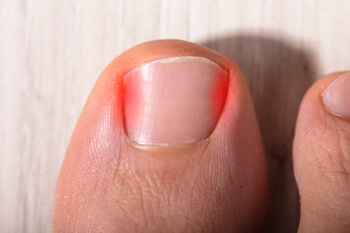
Lansdowne, PA
(610) 626-3338

Lansdowne, PA
(610) 626-3338

When a toenail, most commonly on the big toe, becomes embedded in the skin surrounding it, it is known as an ingrown toenail. This results in pain, redness, swelling, and sometimes infection if not properly cared for. In some cases, an ingrown toenail can break the skin, leaving it vulnerable to infection. In the worst cases, an ingrown toenail can develop into lesions filled with fluid that can emit a foul odor. Causes of ingrown toenails include rounding the corners of the nail, pressure from tight footwear, and repetitive trauma sustained in certain sports. There are many more contributing factors to the formation of ingrown toenails. Among them are certain diseases, like diabetes, as well as obesity, poor foot hygiene, and genetics. At-home measures to correct this condition include soaking the feet in Epsom salt, trimming the toenails straight across, and wearing shoes that provide ample room for the toes to move. If ingrown toenails become a common occurrence, it is a good idea to consult a podiatrist for further treatment options.
Ingrown toenails may initially present themselves as a minor discomfort, but they may progress into an infection in the skin without proper treatment. For more information about ingrown toenails, contact Dr. George Yarnell of Pennsylvania. Our doctor can provide the care you need to keep you pain-free and on your feet.
Ingrown Toenails
Ingrown toenails are caused when the corner or side of a toenail grows into the soft flesh surrounding it. They often result in redness, swelling, pain, and in some cases, infection. This condition typically affects the big toe and may recur if it is not treated properly.
Causes
You are more likely to develop an ingrown toenail if you are obese, have diabetes, arthritis, or have any fungal infection in your nails. Additionally, people who have foot or toe deformities are at a higher risk of developing an ingrown toenail.
Symptoms
Some symptoms of ingrown toenails are redness, swelling, and pain. In rare cases, there may be a yellowish drainage coming from the nail.
Treatment
Ignoring an ingrown toenail can have serious complications. Infections of the nail border can progress to a deeper soft-tissue infection, which can then turn into a bone infection. You should always speak with your podiatrist if you suspect you have an ingrown toenail, especially if you have diabetes or poor circulation.
If you have any questions, please feel free to contact our office located in Lansdowne, PA . We offer the newest diagnostic and treatment technologies for all your foot care needs.